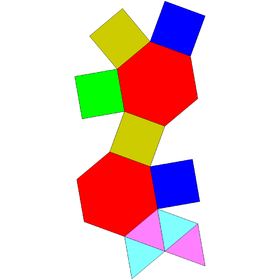Augmented hexagonal prism
| Augmented hexagonal prism | |
|---|---|
 | |
| Type | Johnson J53 – J54 – J55 |
| Faces | 4 triangles 5 squares 2 hexagons |
| Edges | 22 |
| Vertices | 13 |
| Vertex configuration | 2x4(42.6) 1(34) 4(32.4.6) |
| Symmetry group | C2v |
| Dual polyhedron | monolaterotruncated hexagonal bipyramid |
| Properties | convex |
| Net | |
 | |
In geometry, the augmented hexagonal prism is one of the Johnson solids (J54). As the name suggests, it can be constructed by augmenting a hexagonal prism by attaching a square pyramid (J1) to one of its equatorial faces. When two or three such pyramids are attached, the result may be a parabiaugmented hexagonal prism (J55), a metabiaugmented hexagonal prism (J56), or a triaugmented hexagonal prism (J57).
Construction[edit]
The augmented hexagonal prism is constructed by attaching one equilateral square pyramid onto the square face of a hexagonal prism, a process known as augmentation.[1] This construction involves the removal of the prism square face and replacing it with the square pyramid, so that there are eleven faces: four equilateral triangles, five squares, and two regular hexagons.[2] A convex polyhedron in which all of the faces are regular is a Johnson solid, and the augmented hexagonal prism is among them, enumerated as .[3] Relatedly, two or three equilateral square pyramids attaching onto more square faces of the prism give more different Johnson solids; these are the parabiaugmented hexagonal prism , the metabiaugmented hexagonal prism , and the triaugmented hexagonal prism .[1]
Properties[edit]
An augmented hexagonal prism with edge length has surface area[2]
It has an axis of symmetry passing through the apex of a square pyramid and the centroid of a prism square face, rotated in a half and full-turn angle. Its dihedral angle can be obtained by calculating the angle of a square pyramid and a hexagonal prism. The dihedral angle between two adjacent triangles in a square pyramid is . The dihedral angle between both square and hexagon in a prism is . The dihedral angle between square-to-square on the prism edge is , the hexagon's internal angle. Therefore, for the augmented hexagonal prism, the dihedral angle of the square-to-triangle in a square prism is , and that of the square-to-triangle faces on the edge in which the square pyramid and hexagonal prism are attached is .[4]
References[edit]
- ^ a b Rajwade, A. R. (2001). Convex Polyhedra with Regularity Conditions and Hilbert's Third Problem. Texts and Readings in Mathematics. Hindustan Book Agency. p. 84–89. doi:10.1007/978-93-86279-06-4. ISBN 978-93-86279-06-4.
- ^ a b c d Berman, Martin (1971). "Regular-faced convex polyhedra". Journal of the Franklin Institute. 291 (5): 329–352. doi:10.1016/0016-0032(71)90071-8. MR 0290245.
- ^ Francis, Darryl (August 2013). "Johnson solids & their acronyms". Word Ways. 46 (3): 177.
- ^ Johnson, Norman W. (1966). "Convex polyhedra with regular faces". Canadian Journal of Mathematics. 18: 169–200. doi:10.4153/cjm-1966-021-8. MR 0185507. S2CID 122006114. Zbl 0132.14603.












